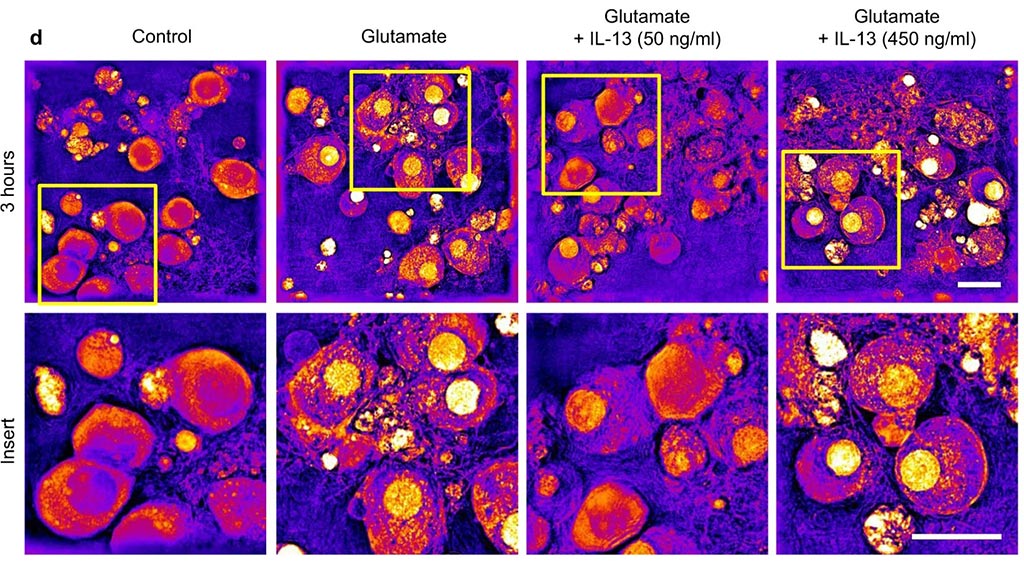The Roselli Lab at the University of Ulm have been researching potential avenues to reduce neuronal death after traumatic brain injury, and uncovered a key role for interleukin-13, published in Nature Communications this month (Interleukin-13 and its receptor are synaptic proteins involved in plasticity and neuroprotection)1. They used Nanolive’s live-cell imaging to track changes in the neuron nucleus to quantify cell death and compare the neuroprotective effect of different treatments.
Imaging techniques which use fluorescence, or a high-power light source to image neurons generate high amounts of phototoxicity, limiting either imaging frequency or experimental duration2. Perhaps more importantly, these methods can inflict damage on fragile structures such as neural dendrites3, which introduces artifacts into experiments and results in less biologically relevant data. Therefore, Nanolive’s label-free imaging is a key tool for imaging these delicate cells.
Author Florian olde Heuvel commented “It was exciting to use Nanolive live-cell imaging to study the effects of Interleukin-13 on glutamate induced excitotoxicity in primary rat cortical neurons; the label-free 4D imaging enabled us to experimentally trace and analyze nuclear pyknosis and cell death in real time. Nanolive was a great help and it continues to be a strong addition to our projects.”
The figure below shows how clearly the chromatin condensation that occurred during nuclear pyknosis could be seen, using Nanolive’s refractive index imaging. Greater condensation is indicated by brighter yellow nuclei, indicating cell death.

From Figure 8. Li, S., olde Heuvel, F. et al.1, Scale bar: 20 μm
Nanolive imaging is so versatile and can be used for many different applications in different cell types- we love seeing the many different ways it can help to drive new discoveries!
You can find more examples of imaging neurons with Nanolive on our dedicated Neurosciences website page.
References:
(1) Li, S.; olde Heuvel, F.; Rehman, R.; Aousji, O.; Froehlich, A.; Li, Z.; Jark, R.; Zhang, W.; Conquest, A.; Woelfle, S.; Schoen, M.; O´Meara, C. C.; Reinhardt, R. L.; Voehringer, D.; Kassubek, J.; Ludolph, A.; Huber-Lang, M.; Knöll, B.; Morganti-Kossmann, M. C.; Brockmann, M. M.; Boeckers, T.; Roselli, F. Interleukin-13 and Its Receptor Are Synaptic Proteins Involved in Plasticity and Neuroprotection. Nat Commun 2023, 14 (1), 200. https://doi.org/10.1038/s41467-023-35806-8.
(2) Magidson, V.; Khodjakov, A. Chapter 23 – Circumventing Photodamage in Live-Cell Microscopy. In Methods in Cell Biology; Sluder, G., Wolf, D. E., Eds.; Digital Microscopy; Academic Press, 2013; Vol. 114, pp 545–560. https://doi.org/10.1016/B978-0-12-407761-4.00023-3.
(3) Harnett, M. T.; Makara, J. K.; Spruston, N.; Kath, W. L.; Magee, J. C. Synaptic Amplification by Dendritic Spines Enhances Input Cooperativity. Nature 2012, 491 (7425), 599–602. https://doi.org/10.1038/nature11554.
Read our latest news
Cytotoxic Drug Development Application Note
Discover how Nanolive’s LIVE Cytotoxicity Assay transforms cytotoxic drug development through high-resolution, label-free quantification of cell health and death. Our application note explores how this advanced technology enables real-time monitoring of cell death...
Investigative Toxicology Application Note
Our groundbreaking approach offers a label-free, high-content imaging solution that transforms the way cellular health, death, and phenotypic responses are monitored and quantified. Unlike traditional cytotoxicity assays, Nanolive’s technology bypasses the limitations...
Phenotypic Cell Health and Stress Application Note
Discover the advanced capabilities of Nanolive’s LIVE Cytotoxicity Assay in an application note. This document presents a detailed exploration of how our innovative, label-free technology enables researchers to monitor phenotypic changes and detect cell stress...



